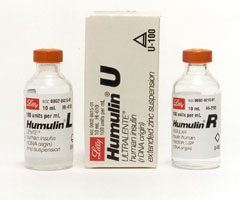
| Shown are some of the many insulin products available for pets. The key to dealing with diabetes is continual monitoring, with diligent and accurate insulin administration. |
I
ntroduction: Diabetes is common in dogs; usually a form of diabetes known as insulin-dependent diabetes mellitus (IDDM) affects middle-aged to older, overweight dogs. The literal translation of diabetes mellitus is "sweet urine." Because diabetes is a remarkably complex disease, only a brief summary is given here.Causes and Clinical Signs: This problem occurs as a result of a series of abnormalities in the body’s normal metabolism of sugars. These abnormalities begin with the decline in insulin stimulation of the body’s cells. (Insulin is an important hormone produced by the pancreas.) In dogs with IDDM, this decline in insulin stimulation usually occurs as a result of a failure of the pancreas to produce enough insulin to meet the body’s needs.
Insulin normally causes glucose (sugar) from the bloodstream to enter all the cells of the body. Glucose provides the necessary energy for each cell to function. Without enough insulin, blood glucose climbs to abnormally high levels, yet falls to low levels inside the cells. The body receives a response from the cells that not enough energy sources are arriving and that the body is basically starving. Therefore, one of the most common symptoms of diabetes mellitus is an increase in appetite. Meanwhile, the kidneys, the body’s natural filter system, are overwhelmed by the massive quantities of blood glucose and begin allowing glucose to spill over into the urine (hence, the term "sweet urine"). The extra glucose in the urine begins to pull in water from the rest of the body which the kidneys then excrete. This then leads to the most common symptom seen in diabetic dogs, the increased need to urinate, often resulting in accidents in the house. The dog then attempts to make up for the lost water by drinking abnormally large quantities of water.
As the disease progresses, the animal begins to lose weight, can develop cataracts and lose vision, and becomes very susceptible to infections, especially of the urinary tract and skin. The body, perceiving that it is starving, begins to metabolize other sources of energy, particularly fats. Fats are broken down into fatty acids which accumulate in the body as ketones. The word ketone is a specialized term for a limited group of fatty acids which tend to accumulate in untreated diabetic animals. A syndrome called diabetic ketoacidosis (too much acid accumulation as a result of ketone formation in a diabetic animal) develops. An animal with untreated diabetic ketoacidosis may rapidly slip into a diabetic coma and die.
In summary, the predominant clinical signs are increased thirst (polydypsia), increased urination (polyuria), increased appetite (polyphagia), and weight loss. Occasionally, an owner will notice blindness as the primary sign.
Diagnosis:
The diagnosis of diabetes is achieved with results from blood and urine testing, in conjunction with observation of the classical clinical signs. Increased glucose and acidic products in the blood, along with increased glucose and possibly ketones in the urine, are typical results of these tests.Treatment: The key to treating diabetes mellitus (IDDM) in dogs is insulin therapy. Insulin must be properly given by injection; consequently, owners of diabetic dogs are instructed how to give an injection of insulin. One important guide in insulin usage is the need to carefully roll the bottle rather than shake it, in order to preserve the delicate structure of the insulin in the solution. Another is the need to administer fresh and not expired insulin. Treatment of a diabetic dog may also include IV (intravenous) fluid therapy, hospitalization, antibiotics, and diet changes. Regular checkups and careful monitoring of weight and blood glucose levels are extremely important in the maintenance of a diabetic dog.

|
|